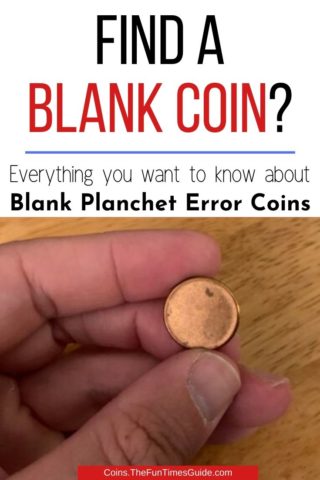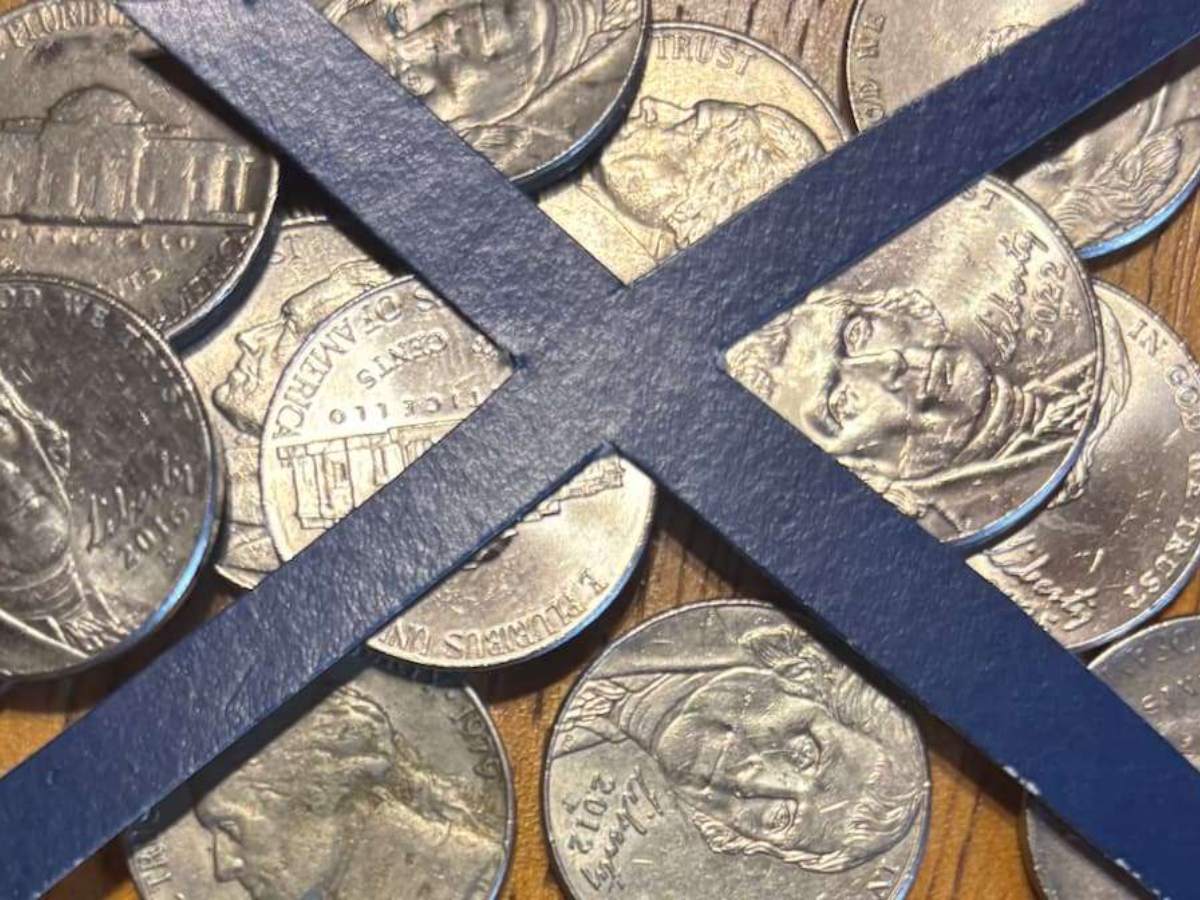Do you know the answer?… What is a blank coin called?
A blank coin with a raised rim but no heads or tails design is called a blank planchet.
Blank planchet error coins are made when the round piece of metal that is supposed to be struck into a finished coin is somehow skipped by the die presses in the coin minting process.
A blank coin (or blank planchet, if it already has its rim) is one of the neatest kinds of mint mistakes you’ll find.
You’re probably wondering if blank planchet error coins are rare or valuable.
Read on to find out more about these no heads and no tails error coins, including:
- How they’re made
- If they’re legal-tender coins
- Whether blank planchet error coins are common or rare
- Where you can find them
- How much they’re worth
How Are Coin Blanks Made?
One of the earliest steps in the minting process involves stamping out round pieces of metal from a larger sheet of metal. This happens in the blanking process, as seen in this video:
Eventually, those round blanks go through the upsetting machine, where rims are added:
When the rims are upset, the blank officially becomes a planchet. That’s the state during which the coin is ordinarily struck by a die to become a coin.
Blank planchets errors are categorized 2 ways:
- Blank coin without an upset rim
- Planchet (with a raised rim)
Often, a blank without a rim is worth more than a planchet with a rim. Values vary depending on the denomination for which the coin blank or planchet is intended.
Are Blank Coins Considered Money?
Technically, no.
A coin doesn’t become legal tender until it’s struck and the necessary inscriptions and design elements are stamped onto the coin. Therefore, blank planchets are not legal tender and would not be accepted as money by a merchant.
On the other hand, an automatic vending machine likely would accept a blank planchet as money because the piece is of the correct weight and metallic composition.
- What is legal-tender money, exactly? — The phrase legal-tender surely gets tossed around a lot. So, what does it mean? In the case of United States money, legal-tender currency is any coin struck by the United States Mint and any Federal Reserve Notes (paper money) printed by the Bureau of Engraving and Printing.
- Do all coins & currency have to be accepted as money? — Here’s something that may surprise you. While all United States legal-tender money is okay to use for “all debts public and private” (as seen printed on Federal Reserve Notes), merchants are not legally mandated by law to accept all coins or banknotes. This is why many stores and even banks refuse to take large amounts of pennies and why certain stores place restrictions on banknotes with denominations higher than $20 or $50.
Are Blank Planchet Error Coins Rare?
Even though you won’t find blank planchet error coins in your pocket change very often, they aren’t necessarily rare.
So, how often do blank planchets make it out?
The answer to that question is not exactly known.
- Every day, a small but significant number of blank planchets somehow end up skipping the coin die presses.
- Sometimes, blank planchets are intentionally removed from the US Mint for distribution.
- Often, blank planchets are given out as special gifts or as presentation pieces to school groups.
It is when these pieces are later spent as money that they end up in your pocket change.
So… while blank planchets are scarce, they aren’t necessarily rare coins. (Here’s the difference between rare and scarce coins.)
However, blank coins with no raised rims are often scarcer than coins with raised rims — depending upon type. This is reflected in comparative pricing between the different types of blank planchets.
What If A Blank Coin Has A Finished Edge?
Maybe you’ve found a coin with no heads or no tails, but it has a reeded edge or edge lettering. What does that mean?
If a blank coin has a reeded edge (those vertical grooved lines seen on the edges of dimes, quarters, half dollars, and some dollar coins) then it is NOT an error coin.
Rather, it’s a finished coin that has had its faces ground off.
Why would someone do that? Let your imagination run wild in trying to figure that out! But, the bottom line is blank coins with reeded edges are not errors.
Why is it not an error coin? Because the reeded edges are stamped into the coin in the same process that the heads and tails designs are also struck. So, if the reeded edge was stamped into the coin, the heads and tails were, too.
Keep in mind… blank coins with lettered edges may be legitimate errors. Unlike the edge reeding that is stamped into the coin when the faces are struck, edge lettering seen on golden dollars are struck onto the coin at a different stage — as discussed in this video:
If you find a blank planchet with lettered edges, check the surfaces to make sure there are no signs that the heads and tails designs were sanded off. You may want to take your lettered-edge blank planchet to a numismatic professional, such as a coin dealer, to make sure it’s an authentic mint error.
Where To Find Coin Blanks
You are likely to find blanks just about anywhere — including spare change. But if you want to maximize your chances of finding blank planchet error coins, you’ve got to look through bank rolls.
Check out how coin collectors in these next 2 videos found blank planchets while searching through coin rolls:
How Much Are Blank Coins Worth?
Blank planchet error coin values range widely, depending on the individual coin.
In general, coin blanks and blank planchets intended for current pennies, nickels, dimes, and quarters are worth $3 to $10. Blanks for older coins or silver pieces are worth much more.
Here are some examples:
Blank Planchets (Blank Coins With Raised Rims)
- 95% copper penny — $2.50+
- Steel penny — $65+
- Nickel — $8+
- Silver dime — $35+
- Copper-nickel dime — $3.50+
- Silver quarter — $125+
- Copper-nickel quarter — $4.50+
- 40% silver half dollar — $125+
- Copper-nickel half dollar — $85+
- 90% silver dollar — $1,500+
- Eisenhower copper-nickel dollar — $90+
- Susan B. Anthony dollar — $110+
- “Golden” dollar — $60+
Blank Coins Without Raised Rims
- 95% copper penny — $3.50+
- Steel penny — $50+
- Nickel — $12+
- Silver dime — $45+
- Copper-nickel dime — $2.50+
- Silver quarter — $150+
- Copper-nickel quarter — $6+
- 40% silver half dollar — $175+
- Copper-nickel half dollar — $125+
- 90% silver dollar — $1,600+
- Eisenhower copper-nickel dollar — $150+
- Susan B. Anthony dollar — $140+
- “Golden” dollar — $225+
*Values for blank planchet error coins listed above are rough estimates. And, as with most other error coins, blank planchets are often priced and traded upon the merits of the individual coin.
Other Types Of Planchet Errors
Like this post? Save it to read again later… or share with others on Pinterest!





